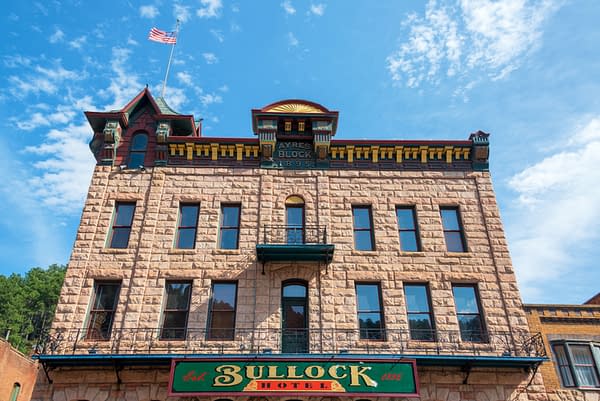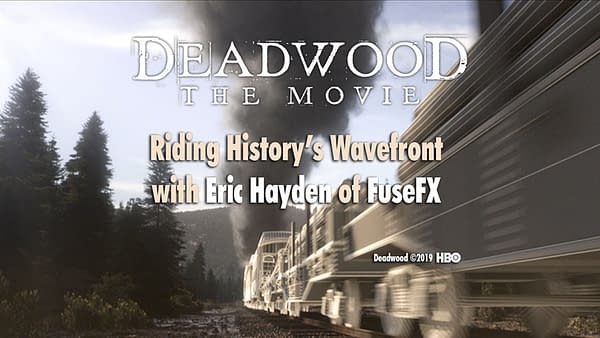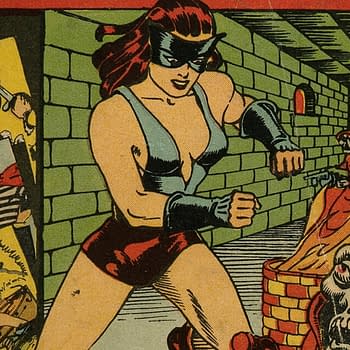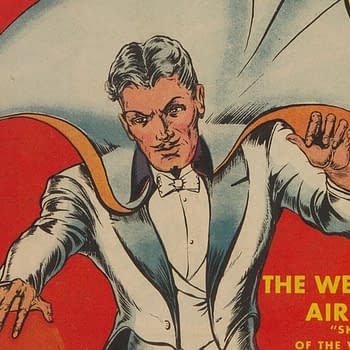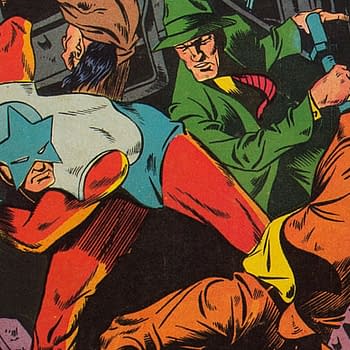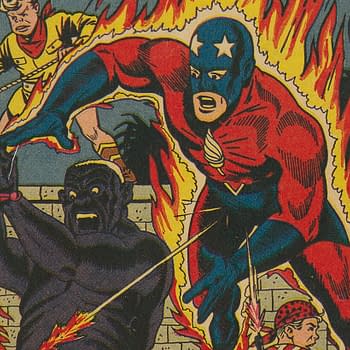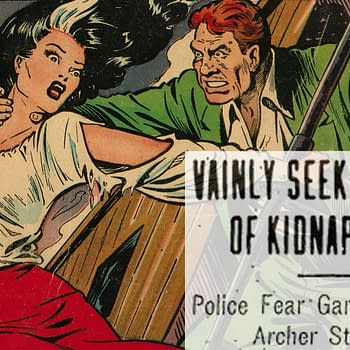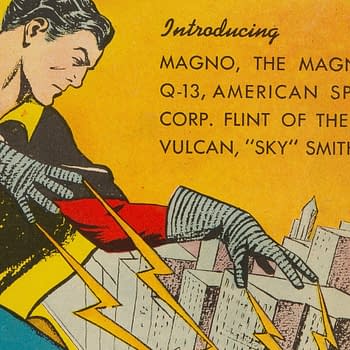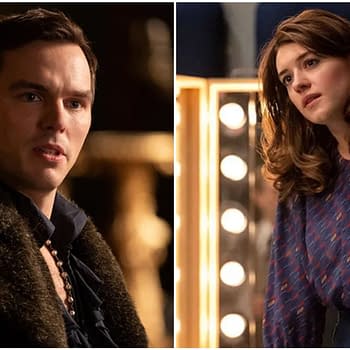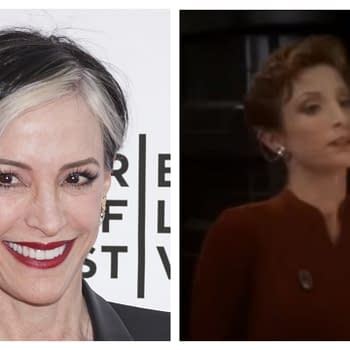Posted in: HBO, TV | Tagged: David Milch, Deadwood the movie, FuseFX, george hearst, Seth Bullock
"Deadwood: The Movie" – Riding History's Wavefront with Eric Hayden of FuseFX
It took me to the end to realize exactly what it is that makes Deadwood so good. There have been numerous articles about the captured magic contained in the series since it debuted in 2004. Countless commentaries note the seemingly effortless genius of writer David Milch. Discussions of the series often mention the special chemistry among the cast and crew. We've had a few such talks ourselves here at Bleeding Cool, interviewing actors Earl Brown, Molly Parker, Brad Dourif, and Robin Weigert about their return to the environs of the Black Hills for Deadwood: The Movie. And even the careful craft of the sets, costumes and VFX have contributed substantially to the environment of Deadwood as a living, breathing thing.
The special quality of Deadwood is about all those things, but those things all come from the same place. Deadwood allowed David Milch to tell us what makes him tick: his well-chronicled struggles in years past with gambling and substance abuse. His fortunes made and lost. Perhaps even his own trepidation over the unstoppable rush towards the future. All tucked away in Deadwood's struggle to go from lurid mining camp to respectable town in a State of the Union. But more importantly, that same journey also contains a sort of dime novel larger-than-life mix of loyalty, humor, cunning, and force of will that makes David Milch who he is.
Every bit of that is here on the screen: not in the distant black and white of an 1880s photograph, but in high resolution color that's sometimes muddy, bloody, and so real you can smell it. Milch seems to have felt at home there, among the characters of Deadwood. They represent the kind of humanity that was recognizable in the 1880s and every moment since, and Deadwood's magic has been conjured up by the fundamental idea that these characters seem like people you could know today despite 125 years of distance. Milch's genius indeed, but perhaps not so effortless as it seemed. Pushing the boundaries of a frontier always has its price.
Is it worth it? Milch's Deadwood tells us that it can be, but even as Deadwood: The Movie stuck the landing, it also leaves the answer up to the viewer, in the end. A quote from a famous figure from American history came to mind as I watched Deadwood: The Movie: "Neither a wise man nor a brave man lies down on the tracks of history to wait for the train of the future to run over him."
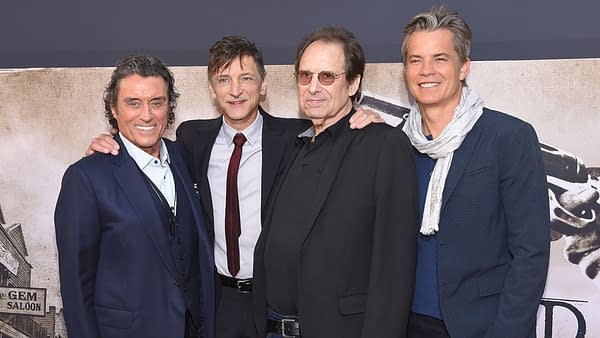
Of course, that's not from 1889 South Dakota. It's Dwight D. Eisenhower in 1952, and although he became an able President, the historic freight train of the Cold War ran over him anyway. By the time he was done, he was sounding a warning against what he called the "scientific-technological elite" that would have had Al Swearengen or Seth Bullock nodding along in agreement 70 years prior, recognizing George Hearst as a previous part of that unrelenting march into the future.
Hugo Jarry, commissioner from Yankton put it best in Deadwood Season 2: "You cannot fuck the future, sir. The future fucks you."
Important moments in American history like the Cold War of Eisenhower's 1950s and the then-impending "closure of the frontier" represented by North Dakota and South Dakota's 1889 statehood tell us — should prove to us, really — that the cliche about not knowing the past dooming us to repeat it is wrong. Repeating the past is a feature, not a bug. History is a resonating wave, carrying us into the future whether we're ready for it or not. History's wavefront is unfailingly transformational, and sometimes downright violent.
As regular BC readers will know, I'm usually the person here who researches such history, rather than interviewing the creators of our fictional past, present, and future — but Deadwood is something special, and when I got the opportunity to interview one of the architects of that fictional past in Eric Hayden, Deadwood: The Movie's VFX Supervisor for FuseFX, I was curious about the processes they used to transport us back to the period of time that Deadwood represents.
Sequential Art at Scale
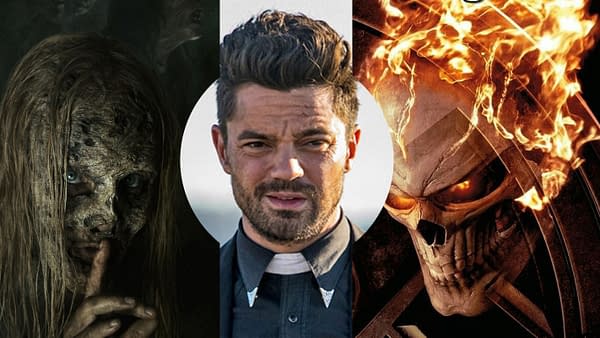
When I looked FuseFX up to see what other series and films they're involved in that I might be familiar with, I was surprised to see that the answer is: just about everything. Or at least an awful lot of the stuff that we cover at Bleeding Cool. American Horror Story, Agents of SHIELD, Preacher, The Orville, American Gods, Runaways, The Walking Dead, Mr. Robot, Legion, and quite a bit more.
There's lots of stuff with comic book origins on the list, and as I started talking to Hayden, I got an inkling of how comic book culture has seeped into the process of FuseFX's production that I didn't really expect. Over the years, some very accomplished people in the comic book business have floundered when it comes to television and film, and I've always chalked it up to the dynamics of collaboration at scale. It only takes a small handful of people to create and publish a comic book (only one or two people if they are talented and industrious!), while in film, it typically takes hundreds of people even on modest endeavors. Television and film takes a different mindset, more money, and more time. That's sometimes a bit of an adjustment for comic book creators who cross the aisle, so to speak, to film and television.
But perhaps after a decade+ of comic book properties ascendant in film and on television, we're seeing a meeting of the minds from those two creative cultures. It's hard to define this, so I'll just say: Hayden talks like a comic book editor. Despite that, he tells me that FuseFX has some serious scale indeed: as many as 25 people at FuseFX worked on Deadwood: The Movie at times, and they have 200 people or more at FuseFX across offices in LA, NYC, and Vancouver, pending seasonal needs. But even among heavyweights like The Walking Dead and Mr. Robot, Deadwood has been special for the company.
"The Deadwood series became the catalyst for all three partners to meet and work together. Dave was the client-side VFX Supervisor, while I filled the role as the VFX Producer and Jason, the Flame Artist. Ultimately, our synergy during the series led to the decision to work together and create what is known as FuseFX today. Deadwood's feature release really represents an exclamation point to the 16-year relationship we've had, and the tremendous growth we've all built together," adds Tim Jacobsen, FuseFX Co-Founder/CDO.
Of course, fans have been waiting to see a conclusion to this landmark series since Deadwood Season 3 originally aired in 2006. Tentative plans were subsequently announced on a few occasions since then, only to seemingly fade away. And then, against all odds, the on again, off again project was set in motion — and with that motion came the weight of over a decade's worth of expectations.
"When I first got the call about Deadwood, it was to join the directors and the producers on a director's location scout," Hayden recalls. "The call was 'hey I need you to turn around and go join them' at Frazier Park to go look at locations for Deadwood. And I thought 'wow, ok, well that's a big ask to step into those shoes'. But from the moment I got on the bus with Dan Minahan, Gregg Fienberg, Scott Stephens and Dave Klein the director of photography… from that moment I don't want to sound cheesy but I knew I was involved with something special. Without even reading the script, the reverence to the piece was absolutely tangible from everyone there."
The Train Arrives in Deadwood, With an Expectation of Speed
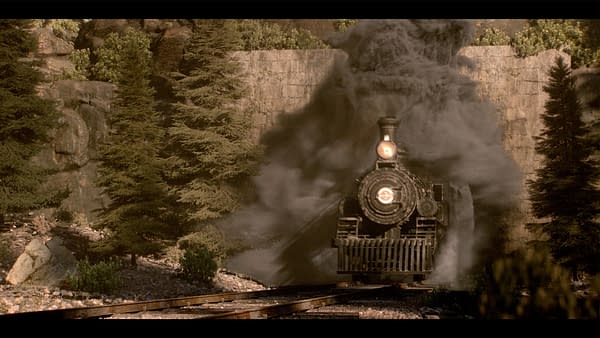
Deadwood: The Movie represented a different sort of challenge than series like Agents of SHIELD, Luke Cage, or True Detective. Many of those series show you things that don't, can't, or shouldn't exist in the world and make you believe they're real. The VFX of the past is another matter. A hallmark of Deadwood from the beginning has been to use the town's history as a framework to tell this tale. It has to feel familiar. It has to live up to the legend that's in your mind.
You likely think you know what the past looks like. You learned about it in school or have seen old photos, or other movies that have told tales of those particular times perhaps, and you've built up a mental idea of what the past looks like in your head.
Of course, you're probably wrong about what you think about the past. Part of what makes Deadwood great has been that they seem to have recognized that and figured out how to deal with it. That's why I wanted to talk to Eric Hayden. How did they bypass our often fragile notions of the past to actually take us there?
When I put that question to Hayden, he used the example of the train from the opening scene. It was important that they get that right, because in just a few seconds, it tells us that some time had passed since last we visited Deadwood (as the railroad hadn't made it to town yet during the original series), and plants the seeds of what was yet to come — in the form of telephone poles. Hayden and the FuseFX team had a few scant seconds to make this moment real, and in addition to the accuracy of countless small details, they changed one important thing about the scene that made us believe:
"There is an expectation of speed," Hayden points out. "The maximum speed of a period-accurate locomotive is significantly slower than how we depicted it. If we had run it at the accurate speed you would not have had that feeling of technology bursting through the landscape."
As someone with a serious interest in history I'll admit I like that sleight of hand a lot. It's the right kind of trade-off, as it transports us back to this fictional 1889 Deadwood, where we'll get hooked on countless details that are more accurate. There's almost a throwaway detail among the countless trees, blades of grass, bursts of smoke that had me nodding in appreciation of their attention to detail here: the blue glass insulators on the telephone poles. I'm a collector of many vintage things, and although old blue glass insulators are not among them, I've known people around here who are obsessed with collecting them, so it's something that shows me the historical love that FuseFX put into this project.
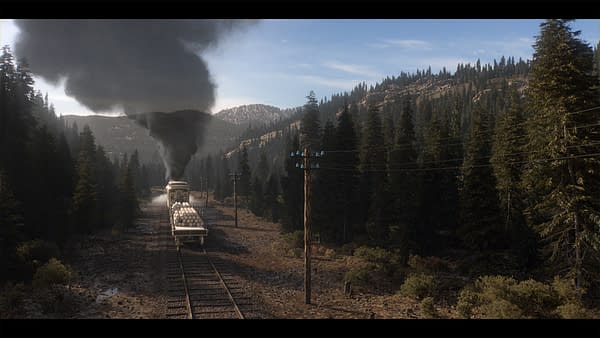
"The production designer had practical telephone poles on set for the scene when Hearst's crew is raising the telephone poles," recalls Hayden, "They had these beautiful glass insulators on them. And I just wanted to be sure that when we recreated the polls that they continued that type of accuracy throughout. The structure of the poles being erected on basically stripped tree trunks, and the glass insulators was very important."
Technology Rupturing into the Deadwood Landscape
Deadwood: The Movie jumped forward in time from the prior series to 1889, the moment that the former Dakota Territory became the states of South Dakota and North Dakota. It's a transformational time of enormous importance for the country and the world, which serves as a backdrop for the film in a hundred little ways. Because the country and the world were getting networked: the Transcontinental Railroad and numerous branches made travel around the country much more simple. Telephone poles were going up everywhere around the country, and just a little before that, submarine telegraph lines were laid at the bottom of the Atlantic and Pacific oceans, making global communications a reality. Thomas Edison had become known as the Wizard of Menlo Park by making his electric light a practical reality, among other things.
These moments are embedded in our culture in ways we don't think of. The changes from the first episode of Deadwood to Deadwood: The Movie encompass the stuff of our legends.
In Deadwood Season 1, Episode 1, a family of prospective pioneers has had their fill of the hard life there, and has decided to go home to Minnesota — I'll avoid the spoiler, but suffice it to say that this is the start of the young girl Sophia's story. Though obviously important, she seems historically incidental among the likes of Wild Bill and Calamity Jane, or even the infamous female Pinkerton Detective Miss Isringhausen (an obvious stand-in for Kate Warne, the first female detective in U.S. history), and yet… at exactly this time in American history, some pioneers traveled the Yellowstone River across Dakota Territory, Montana, and Wyoming in search of what lies somewhere over the rainbow in that gold rush time. And like Sophia's family, they found the living hard and the travel often treacherous, and turned back. Yellow Brick Road or the Yellowstone River, there's still no place like home.
But by the time of Deadwood: The Movie in 1889, the country and its culture had undergone a dramatic change. Networks were changing everything: it was the true rise of the machines. FuseFX was aware of the importance of establishing this change.
"I personally did a lot of research on the period trains," Hayden tells me. "That's where we got our look of the smoke that was coming out of the smokestacks and the way the train exits the tunnel. There's what Dan Minahan (Director of Deadwood: The Movie) referred to as a machine birth — of this technology rupturing into the landscape of Deadwood."
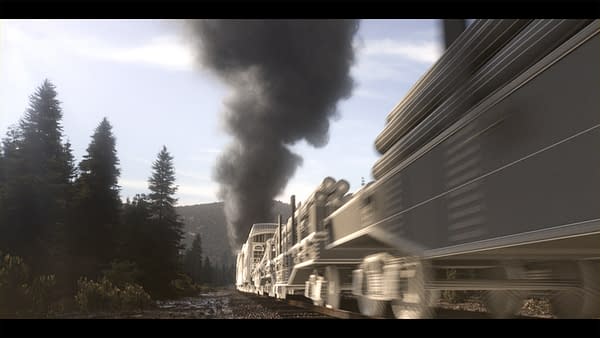
The term "Mechanic" used to denote a profession came into common usage not long before the period that the Deadwood saga covers. We'd think of it in the way we think of "Engineer" today — not the kind that drives a train, but the kind that builds one, among other things. It had the same tenor that "coder" or even "hacker" has today. But mechanics, hackers, and coders are often expected to be artists in the world today, and in VFX it's a requirement. Hayden has a succinct way of explaining the difference: mechanics have become artists by telling stories.
"Every shot needs to tell a story," he explains. "In the best case scenario that story is very clear at the script level and at the director's vision level, so that the artists aren't just going through motions to make it function but rather to make it function for the sake of the emotional impact in the story that's being told.
"When Dan said he wanted to show the violence of this train going through the landscape, being able to say that to the team of artists is so much more informative than saying the train comes out of the tunnel."
Legacy of the Last Singing Cowboy
I grew up near a rural town that was not too dissimilar from 1880s Deadwood in its day, founded by a Civil War colonel during the time my great-grandfather settled here — there was coal in this area instead of gold and silver, and the rail line that Abraham Lincoln worked for here before he became President was owned by captains of industry who were not unlike George Hearst. Of course, that was well over a century before I was born, but the ghosts of that prior time have still crept into my memory — little stories, forgotten traditions, and cultural quirks passed down through the generations of my family and neighbors.
There's a small moment in Deadwood: The Movie that represents a bigger idea: E.B. Farnum is afraid to use the town's telephone. This was not unheard of among my older relatives when I was a kid. Fear of technology and the changes it represented is sometimes palpable.
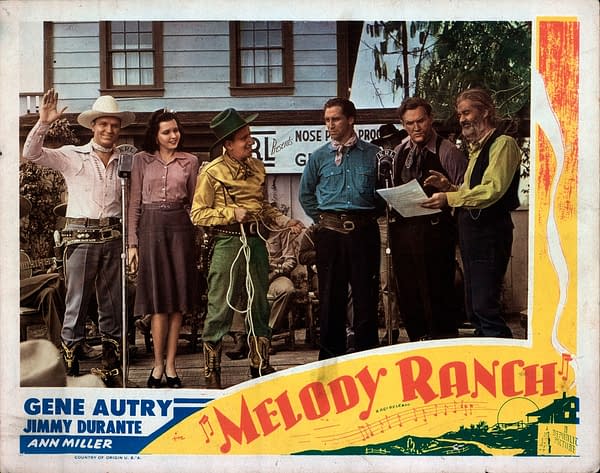
"They went through and restored the facades of all the buildings like the Gem and the Grand Central," Hayden explains, discussing the facelift the set received to indicate that we've jumped forward to 1889. "Then they added the Bullock and Star Hotel as a stone building and there were other buildings that were put in with stone as well. Part of the history of the real Deadwood was that there was a fire and a flood. Actually many fires, but there was one big fire in particular that wiped out the whole town. And most of the places, were then rebuilt with stone and not wood.
"New structures that came in were built in stone. Anytime we were showing new structures we wanted them to be made of stone. The Bullock and Star Hotel in real life is three stories tall. It was at the time like the skyscraper of Deadwood. The limitations for the practical set were such that we could only build a two story building, so we added the third story in visual effects to complete the scale of the building.
"During the series there was a valley of trees, and as the years progressed, the trees were stripped from the hills, and the hills were denuded to allow for the town to expand. So in our work on set extensions we sculpted out a lot of the trees and started putting houses on the hills where they have expanded."
It's apparent that Hayden and FuseFX put a lot of work into thinking through both the sources and reactions for such changes, including, of course, human reactions.
"In the course of the movie, Al Swearengen is very resistant to the idea of telephones," notes Hayden. "I think everyone's perspective was this idea that Deadwood was a sanctuary, and the outside world was kind of intruding on it — but in a way that was allowing for development. The character of George Hearst really represents this intrusion. Whenever we showed where the telephone poles were, it was always through a path that was cut down, the trees are cut down, nature is destroyed. The sanctuary was destroyed to allow for this expansion.
Deep FX?
As I write this piece, the world appears to be gripped in the same kind of machine-fear that E.B. Farnum felt when he used the telephone in Deadwood. The news media seems to be truly terrified of what it considers an unstoppable AI-driven technological terror. Did the Terminator make good on his threat to come back yet again, or has someone remembered Eisenhower's 1950s warning about the military-industrial complex (which, um… same thing, I suppose)? You might think so judging from the reaction to this technology, but no, not quite. What's happening is that Deep Fakes software has put the ability to scramble reality in a very sophisticated way into the hands of… just about everyone.
I asked Hayden about what was on my mind in a different way, since he's on the cutting edge of VFX technology on a very different level. I wondered if he thinks that the quality of VFX will become indistinguishable from reality any time soon. His answer surprised me, and in the process, pointed out the flaw in the Deep Fake concept anyway: in practice, there will always be a tell, because nobody wants to use such technology to mimic reality — they want to use it to tell a story (which is pretty much baked into the Deep Fake name, now that I think about it).
"When we want to see a story, drama is part of it," he explains, about the direction of VFX for film and television. "When we watch a documentary it's more of a dedication to the history. That being said, I don't think they will ever get to a point where we would just not notice that the visual effects are present. I don't really ever want to be in a world where we could do a digital movie and not know that it was digital. I don't know if the goal is ever to replace reality as much as it is to create an artistic version of it."
And that's certainly the goal of Deep Fakes, too. This gets back to his earlier notion of speeding up the train: there's what is real, and what we think is real, and the gap between those things is a measurable quantity.
Deadwood: After The Movie
I'm not surprised when Hayden says there's not much he can tell me about what he's working on currently. Given FuseFX's extensive list of projects, it's hard to even come up with an educated guess. He did also say that he aspires to being a film director himself, and pointed me to a well-crafted and enjoyable science fiction film he's done called Astronaut: The Last Push, starring Khary Payton, Lance Henriksen, and Brian Baumgartner. The film is available on Amazon Prime, and I would suspect we'll see more from Hayden in the director's chair sometime soon.
In the meantime, I'm pleased to say that I can still close out this story with some spoilers — historical spoilers, that is. They will not spoil your viewing of Deadwood: The Movie, or even the Deadwood series, in the slightest. But since this is American history, or an interesting fictional approximation of it anyway… the story of the people we meet in Deadwood who lived to tell the tale, had further tales to tell as well.
For a number of reasons, I'll avoid mentioning the real history of George Hearst during the period encompassing the Deadwood series and Deadwood: The Movie. Best that you watch Deadwood: The Movie first, then look into it yourself. However, his son William Randolph Hearst is another matter, as he would eventually accumulate the kind of power via newspapers and other businesses that even the George Hearst of Milch's Deadwood could only dream of. Along the way, William Randolph Hearst would have a nearly incalculable impact on the course of comic book history. His acquisition of the Yellow Kid comic strip for his New York Journal newspaper is not actually the source of the name "yellow journalism", but it did represent a significant development in the popularity of comics in the United States. One of his top lieutenants, Moe Annenberg, was reportedly the source of printer/publisher/distributor Harry Donenfeld's wealth — which allowed Donenfeld to purchase DC Comics.
Better known is William Randolph Hearst's role in guiding the country into the Spanish-American War in 1898. Ironically, this matter would significantly influence the life of a resident of Deadwood who is well familiar to us: Seth Bullock.
In between the time of the Deadwood series and Deadwood: The Movie, Bullock had befriended a historical figure who would ultimately become more famous than anyone in Deadwood: Theodore Roosevelt. Roosevelt had purchased a ranch in the Dakota Territory, and legend has it that the pair met in the mid-1880s while apprehending some horse thieves.
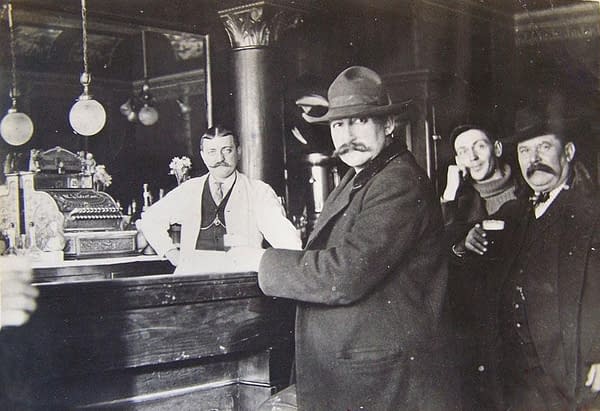
After the customary misunderstanding that's requisite when two heroes meet for the first time, Bullock and Roosevelt became fast friends, and visited each other often in subsequent years. When William Randolph Hearst's New York Journal orchestrated the drumbeats of conflict leading up to the Spanish-American War, Roosevelt and his famous Rough Riders went off to fight in Cuba in 1898.
Wishing to support his friend's efforts, Bullock put together a troupe of 84 volunteers to accompany him under his command in joining the Rough Riders as well — though Bullock and his troupe were still training in Georgia by the time the fighting had ended. But the war had made Theodore Roosevelt a national hero, and he was soon elected Governor of New York, then Vice President under President William McKinley. When McKinley was assassinated, Roosevelt became the youngest man to be President of the United States at age 42.
Undaunted by previous experience in assembling a troupe to help his friend Roosevelt — and, one suspects, hoping to help Roosevelt to avoid the previous President's fate — Bullock again put together a group of 60 cowboys to ride in his friend's Presidential Inaugural parade in 1901. This group included future cowboy movie star Tom Mix. A short time later, Roosevelt appointed Bullock a U.S. Marshall.
The Bullock Hotel still stands in Deadwood to this day — and so, legend has it, does Bullock himself. Regular strange occurrences and sightings of the figure of Bullock appear to have become part of Deadwood lore. Mining towns and Western lawmen legends both often come with their share of ghost stories, and Bullock had both of those things going for him in Deadwood. But such legends usually come with reasons for the haunting attached, which makes one curious about what tales of Seth Bullock's life might have gone as yet untold.
